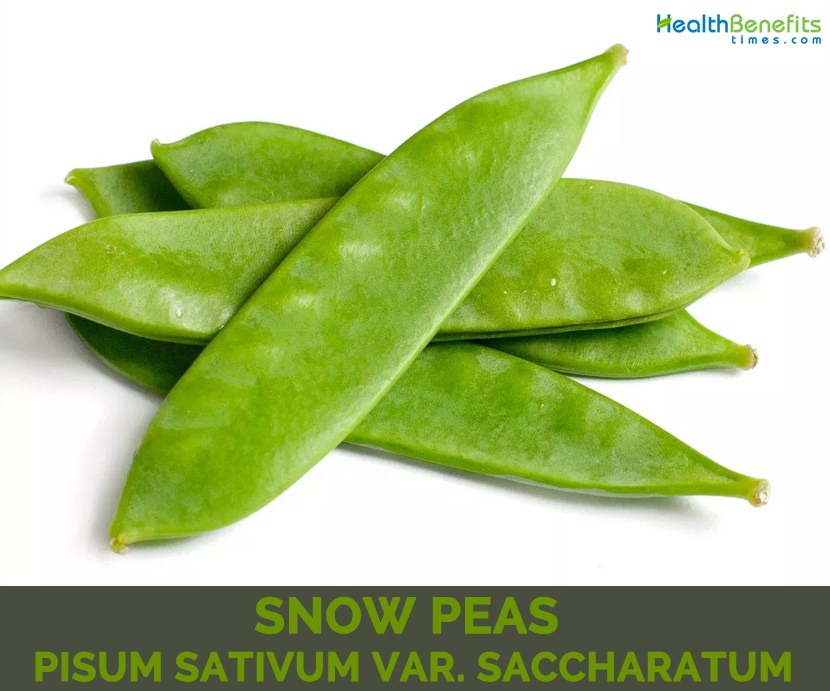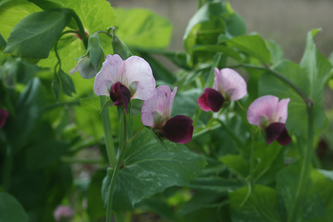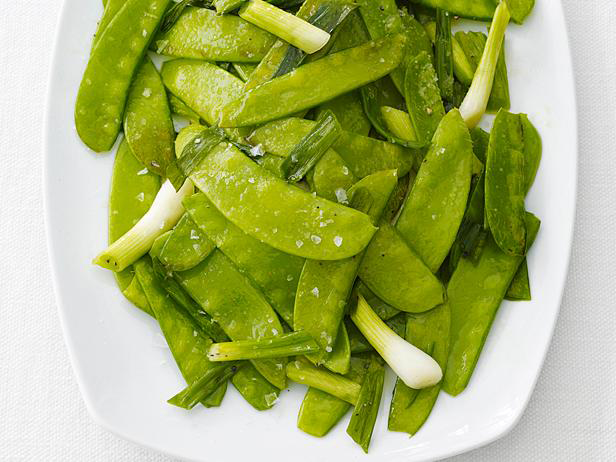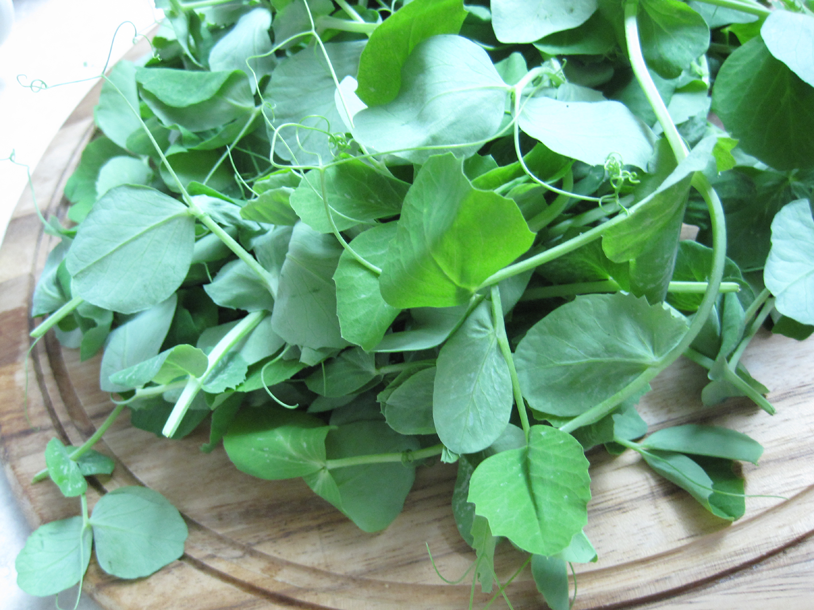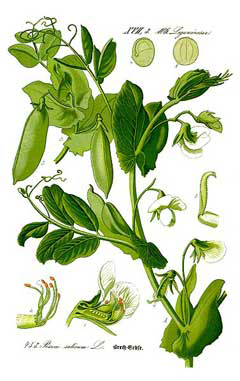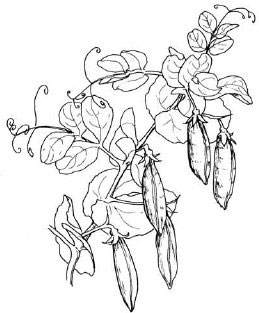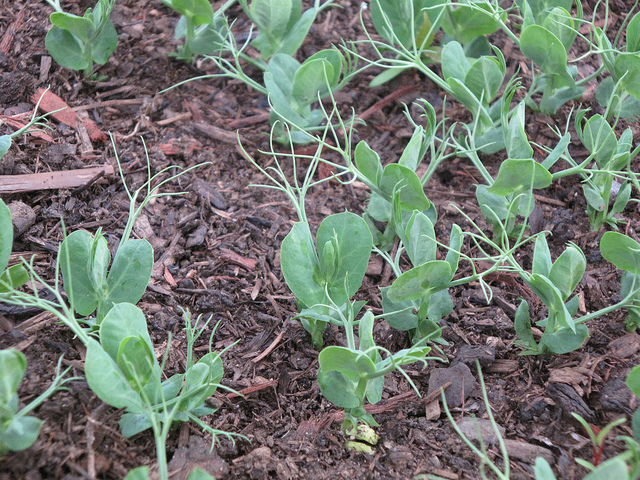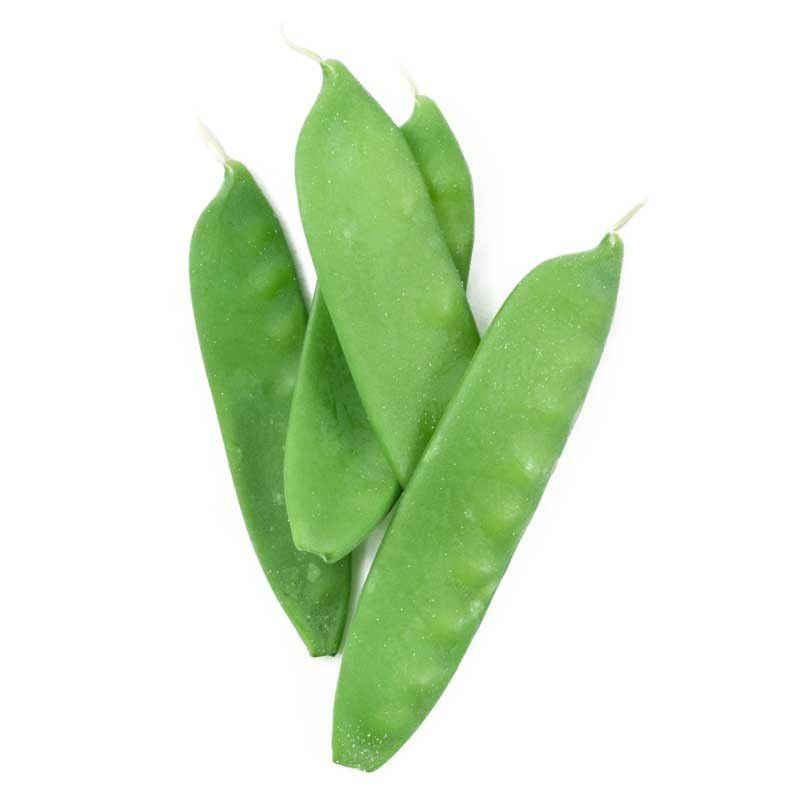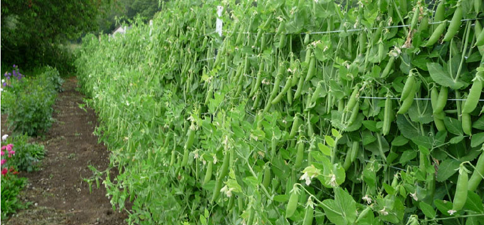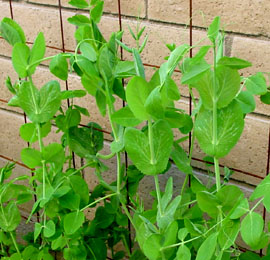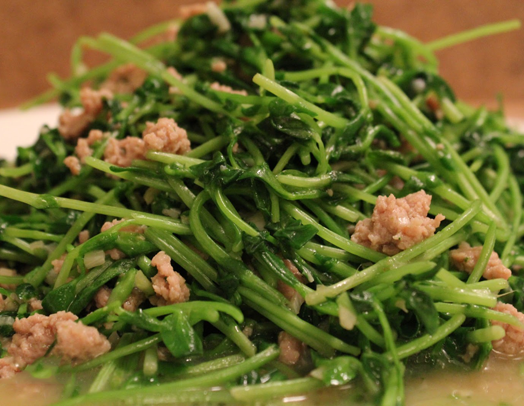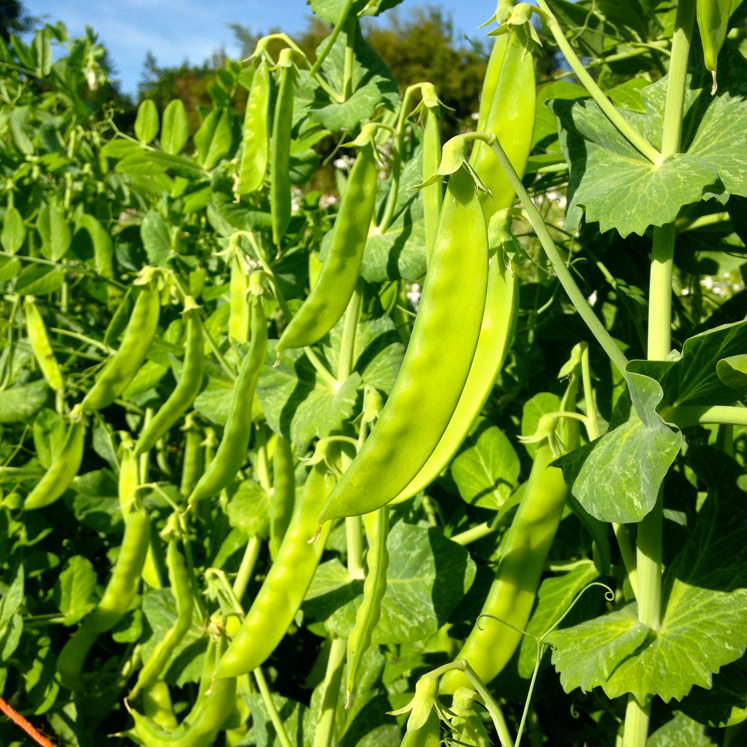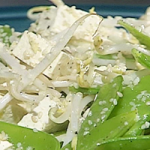| Snow Peas Quick Facts |
| Name: |
Snow Peas |
| Scientific Name: |
Pisum sativum var. saccharatum |
| Origin |
South-western Asia, possibly northwestern India, Pakistan or adjacent areas of former USSR |
| Colors |
Pale green |
| Shapes |
Oblong ovate pod 3.5–11 cm × 1–2.5 cm, straight or slightly curved |
| Taste |
Sweet, Acrid |
| Calories |
26 Kcal./cup |
| Major nutrients |
Vitamin C (42.00%)
Iron (16.38%)
Vitamin K (13.17%)
Vitamin B5 (9.44%)
Valine (8.14%)
|
| Health benefits |
Heart Disease, Bone Mineral Density, Better Vision, Diabetes, Digestion, Immune System, Cancer, Weight Loss, Prevents Anemia, Lowers Blood Pressure, Prevents Osteoporosis, Good for Pregnancy, Cures Insomnia, Nourishes Eye, Relieves Flu, Treats Cramps and Back Pain, As Anti-Inflammatory, Improves Health, Brain Cells, Increases your Energy, Prevents and Destroys Kidney Stones, Prevents Depression |
Snow pea scientifically known as Pisum sativum var. saccharatum is a legume in the Fabaceae ⁄ Leguminosae (Pea family) native to south-western Asia, possibly northwestern India, Pakistan or adjacent areas of former USSR (now Tajikistan, Uzbekistan, Turkmenistan and Krgystan) and Afghanistan. It is a cool season vegetable more specifically a variety of pea eaten whole in its pod while still unripe. Other popular common names of Snow pea are Chinese Pea, Chinese Pea Pod, Chinese Snow Pea, Dry Pea, Edible-Podded Pea, Edible Pod Pea, Field Pea, Garden Pea, Green Pea, Honey Pea, Pea, Peas, Podded Pea, Round-Podded Snow Pea, Round-Podded Sugar Pea, Shelling Pea, Snap Pea, Snow Pea, Sugar Pea, Sugar Snap Pea, Stringless Snow pea and Sweet Pea. It is also known as mange tout in French which translates to ‘eat all’ in English. Also known as Chinese pea pods these pea pods are edible and taste a little milder and sweeter when compared to the normal garden pea. It is supposed that the name snow pea was invented because of the whitish tint present on the pea pod that gives an imaginary snowy effect. On the other side there are possibilities for it to carry the tint as it is harvested right after spring freeze. Initially used as a dry vegetable, it eventually over a period of time became tender and tastier as it evolved.
Snow peas are actually a variety of pea that is actually eaten whole, while the peas are still in the pod. Unlike regular peas, the pods of snow peas do not contain inedible fiber, meaning that they are more palatable and not meant to be discarded. These pods are also a source of good nutrients. These peas are not only popular in Chinese cuisine, but they are popular around the world and are relatively easy to find in most grocery stores and import shops. They take very little effort to prepare, and can be added to a number of meals, or simply munched on for a protein-rich snack! The stems and leaves of the immature plant are used as a vegetable in Chinese cooking, stir-fried with garlic and sometimes combined with crab or other shellfish. These peas were also considered holy and royal by the Egyptians as according to the archaeological evidence peas were found inside tombs of pharaohs.
History
The origin and ancestors of Pisum sativum are still unclear. It is generally held that pea originated in south-western Asia, possibly northwestern India, Pakistan or adjacent areas of former USSR (now Tajikistan, Uzbekistan, Turkmenistan and Kyrgyzstan) and Afghanistan and afterward spread to the temperate zones of Europe. According to Gritton, four centers of origins, namely, Central Asia, the Near East, Abyssinia and the Mediterranean have been acknowledged based on genetic diversity. Lately FAO designated Ethiopia and western Asia as centers of diversity, with secondary centers in southern Asia and the Mediterranean region. At present, Pisum sativum is cultivated in all temperate countries, as a cool season crop in the subtropics and in most tropical highlands. Pea was introduced into the Americas soon after Columbus. Pea was taken to China in the first century. Main producers of dry seeds are the former USSR, China, India and the USA, for green seeds the USA, United Kingdom, France and former USSR. Dry seeds are used as pulse for food and feed, cooked, roasted and ground to flour. Green immature seeds became a major vegetable, they are canned and frozen.
Varieties of snow peas
Snow peas come in both climbing and bush varieties.
- Oregon Giant: 1 meter climber with some resistance to powdery mildew.
- Oregon (bush): 70cm and good for small gardens and children.
- Yakumo Giant: 2 to 2.5 meter climber with purple flowers.
- Yellow podded: 2 meter climber with pink and purple flowers.
- Mammoth Melting: 2 meter climber that is high yielding with a long harvest period.
Health Benefits of Snow Pea
It is indubitable that plant around us has a lot of nutritious for health. Not only special plants that exist as a medicinal plant, but the herb can be achieved from foods of vegetables, legumes, fruits that we consume every day. There are a number of impressive health benefits of snow peas, including weight loss, cancer prevention, improved heart health and many more. Listed below are some of the popular health benefits of Snow Pea
1. Heart Disease
Snow pea consists of considerable amount of potassium and vitamin C; these nutrients can help protect the heart in various ways. Potassium helps to reduce blood pressure and minimize the strain on the cardiovascular system, while vitamin C can induce repair efforts on blood vessels and arteries, thus lowering the risk of coronary heart diseases.(1)
2. Bone Mineral Density
Snow peas consist of numerous minerals that are necessary for the body to increase bone mineral density, such as iron, potassium, and manganese, among others. Although these minerals are found in small amounts, they can help lower your risk of osteoporosis. (2)
3. Better Vision
Vitamin A is one of the critical elements in our vision health, as this antioxidant vitamin can prevent oxidative stress in the retina. This means a lower risk of macular degeneration and a slowdown in the development of cataracts.(3)
4. Diabetes
High levels of dietary fiber in the body mean more control over your blood sugar levels. Fiber is a type of carbohydrate, but it regulates the glucose and insulin levels in your body. This is mostly important for people with diabetes, who need to watch their intake of simple sugars and closely monitor their blood sugar levels to prevent sudden spikes and drops.(4)
5. Digestion
Snow peas consist of suitable levels of dietary fiber that are essential to optimize your digestive processes. Fiber helps to stimulate peristaltic motion, improve nutrient uptake efficiency, and reduce inflammation in the gut that can lead to stomach discomfort.(5)
6. Cancer
Snow pea consists of considerable amount of carotene, which can help prevent the synthesis of the carcinogen inside the body, reduce the formation of cancer cells, and thus lower the incidence of cancer. Additionally, their pods and tender leaves contain large amount of vitamin C and enzymes that can break down nitrosamines, which also make them one of most effective anti-cancer foods.(6)
7. Weight Loss
These delicious little pods are high in dietary fiber and densely packed with valuable nutrients, which makes them quite filling. However, they have an extremely low level of fat and calories, so you can eat these vegetables without any guilt about ruining your diet or going over your calorie allotment for the day. The fiber will also help your digestive system and improve your metabolic speed, further helping with weight loss efforts.(7)
8. Prevents Anemia
The content of Snow Pea is super complete because it turns out to have iron content as well. Iron can prevent us from anemia. Red blood cells in your body will be fulfilled by eating snow peas. That way you will avoid anemia. Iron is also commonly found in green leafy vegetables
9. Lowers Blood Pressure
By eating Snow Pea in a reasonable and orderly, it can be launched and calm the blood flow that flowing in blood vessels throughout the vital tissues in the body. So, that the blood pressure can be controlled and always stable. Meanwhile, it’s good to lowers high blow pressure.
10. Prevents Osteoporosis
As mentioned previously Snow Peas consists of good amount of Vitamin K. This content will provide many benefits for the bone health of your body; it will strengthen bones and prevent osteoporosis or bone loss.
11. Good for Pregnancy
Snow pea is quite beneficial for those you are currently pregnant. Because the minerals and vitamins contained in Snow Peas can nourish the fetus you are carrying. Snow Peas also consists of wonderful amount of Vitamin C, Vitamin K, and also Folic Acid which in turn can give a good effect on the growth of the fetus and will also prevent the fetus from a physical disability.
12. Cures Insomnia
Insomnia disease is commonly related with neurological disorders of the brain and blood flow that exists around the head is not smooth and brain disorders because of their heavy thoughts. Snow Peas can relax the tensions that exist in the brain nerves, soothe, relax the muscles and nerves of the head, the blood flow in the head, causing a person can sleep soundly.
13. Immune System
Vitamin C is also considered one of the most important nutrients in your diet, as it can help to stimulate the production of white blood cells, the main line of defense for the body’s immune system. This will lower your susceptibility to various infections and foreign pathogens. Snow pea also consists of considerable amount of vitamin c thus including it in your regular diet is quite beneficial for boosting your immune system.
14. Nourishes Eye
As we all know that carrots are a wonderful source of Vitamin A, similarly snow peas also consists of good amount of Vitamin A that are essential for our body. And indeed Snow Pea is powerful enough to nourish our eyes. Therefore the Vitamin content contained in peas is quite high as well. Frequent use of snow pea is quite beneficial for nourishing your eyes.
15. Relieves Flu
As already mentioned above that the snow pea consists of appropriated amount of Vitamin C, it is quite beneficial for those who are suffering from flu. Vitamin C contained in snow pea will be able to fight the flu virus and will boost your immune system. Thus, consuming snow peas may be good for your health.
16. Treats Cramps and Back Pain
Snow Peas may help in treating people with severe back pain with a relaxation of muscles of the back, muscle tension, and stress the kidneys. Snow Pea also helps in the absorption of calcium that is beneficial for bone related problems. Symptoms of cramps in the legs and fatigue are usually caused by magnesium deficiency. With the proper intake of Snow Peas it is beneficial to overcome problems of leg cramps.
17. As Anti-Inflammatory
Snow Peas are loaded with anti-inflammatory compounds. Thus regular consumption of snow peas can prevent you from inflammation. Substances present in the peas can also be used as anti-asthma drugs. Inflammation is easily be cured by consuming snow peas frequently.
18. Improves Health Brain Cells
Potassium contained in Snow Peas helps to accelerate the entry of oxygen in the blood vessels and circulation in the tissue surrounding the head, particularly in the brain. Brain cells will get better and be able to function in a way of responding quickly to capture the information that has been conveyed by the nerves of the body. Potassium can educate the child’s motor skills and ways of thinking can lead to a better one.
19. Increases your Energy
The main function of carbohydrates is a source of energy in the body. Each one gram of carbohydrate can produce 4 calories to support energy source in the body when doing activities. The presence of carbohydrates in the body is divided by the number of places such portion is in the blood as glucose cycle for energy purposes, and partly in the liver and muscle tissue that serves as glycogen
20. Prevents and Destroys Kidney Stones
Snow peas have the power to destroy clots and bad cholesterol in the blood vessels. Similarly, Snow Peas can also break and dissolve kidney stones, and then will be discharged with the process of the formation of urine which contains urea, and then supplied to the bladder in order to be discarded.
21. Prevents Depression
As many of us don’t know that magnesium plays an important role in preventing someone from depression. The fewer magnesium levels in the body, then it will increase a person’s risk of developing depression. Meanwhile, Snow Peas consist of wonderful amount of Magnesium, thus regular consumption of snow pea id quite helpful for preventing depression.
https://www.youtube.com/watch?v=TttQiDk6vA0
Traditional uses and benefits of using Snow Pea
- Pea seeds are supposed to cause dysentery when eaten raw.
- In Spain, flour is considered emollient and resolvent, applied as a cataplasm.
- Seed is regarded as contraceptive, fungistatic and spermacidal.
- Dried and pulverized seed has been used as a poultice on the skin to treat many types of skin complaints including acne.
- Oil from the seed, administered once a month to women has shown promise in preventing pregnancy by interfering with the activity of progesterone.
- Antioxidants found in Snow pea help in fighting diseases by enhancing the immunity.
- Anti-aging features helps in reducing signs of aging like wrinkles and dark circles.
- It helps in treating conditions like arthritis and osteoporosis.
- It regulates level of blood sugar in blood and improves insulin production and helps in the treatment of diabetes.
- It enhances body’s metabolism and regulates bowel movements and helps to cure problems like constipation and indigestion.
- It prevents the formation of plague and reduces oxidative stress.
- It decreases stress and strain from the eyes and improves vision.
- It nourishes hair follicles and enhances hair growth. It solves the problem of dry hair, brittle hair and rough hair.
- It is low in calorie and fat and keeps you full for long time thus effective in managing body weight.
Culinary Uses
- Stems and leaves of the immature plant are used as a vegetable in Chinese cooking, stir-fried with garlic and sometimes combined with crab or other shellfish.
- Versatile pea combines well with shrimp, scallops, cashews, citrus, soy sauce, sesame, butter, delicate noodles and tofu.
- Snap peas may be used in a salad, omelet, soup, or stew, or on its own eaten as a substitute for French fries, stuffed, or batter-fried.
- Fresh green pea seed, dried seeds, tender, immature pods, leafy shoots and sprouts are eaten cooked as vegetables.
- Peas are also eaten raw as they are sweet when fresh off the plant.
- Green peas are marketed fresh, canned, or frozen while ripe dried peas are used whole, split, or made into flour.
- In many parts of the world, dried peas are consumed split as dahl, roasted, parched or boiled.
- Roasted pea seed is also used as a coffee substitute.
- Mature pea, which dries naturally in the field, is known as the marrowfat pea.
- Marrowfat peas are mainly grown in Britain and exported to the Far east especially Japan where it is popularly called Maro.
- Fresh peas are often eaten boiled and flavored with butter and/or spearmint as a side dish vegetable.
- Fresh peas are also used in pot pies, salads and casseroles.
- Boiled peas are occasionally sold dried and coated with wasabi as an eye-watering snack.
- In Japan, China, Taiwan and other Southeast Asian countries including Thailand and Malaysia, the peas are roasted and salted, and eaten as snacks.
- In Ethiopia, peas snacks include ‘ eshet ’ (fresh green pea seeds either eaten raw or roasted), ‘ nifro ’ (boiled dry or fresh green pea seeds) and ‘ endushdush’ (seeds soaked first and then roasted).
- Some common pea dishes in Ethiopia include ‘ shiro wot ’ (split pea seeds ground, mixed with spices into stew) and ‘ kik wot’ (split pea seeds boiled and made into stew).
- Dried, rehydrated and mashed marrowfat peas are used as accompaniment to fish and chips or meat pies in Britain.
- Fresh peas are used in various recipes such as aloo matar or matar paneer in India.
- Dried peas are often made into a soup or simply eaten on their own.
- Dried yellow split peas are used to make a traditional dish, pea’s pudding in UK.
- In North America a similarly traditional dish is split pea soup.
- Traditional pea soup called Ärtsoppa used to be eaten on a Thursday, because this was an off-day for the maids and the soup was easy to prepare and also because Friday was a fasting day in Sweden.
- In Cyprus, Greece, Turkey, and other parts of the Mediterranean, peas are used in a stew with meat and potatoes.
- In Greek this stew is called arakas, whilst in Cyprus and Turkey it is called mpizeli or mpizelia .
- Leafy shoots are used as a pot herb in parts of Asia and Africa.
- Tender leafy shots are also used in salads.
- In Chinese cuisine, pea sprouts called dòu miáo are popularly relished in the relatively high-priced stir-fries.
- Pea leaves are often considered a delicacy as well.
How to Store Snow Peas
Snow peas don’t have a long shelf life, so after purchasing or picking these peas, you can store them in your refrigerator for 2-3 days before the quality will begin to diminish. After 2-3 days, the peas will have less of a crunch, and their slightly sweet flavor will also begin to disappear.
Butter Leaf Lettuce, Candied Salmon and Quail Egg Salad
Ingredients
![Butter Leaf Lettuce, Candied Salmon and Quail Egg Salad]()
Dressing
Salad
- 3 cup water
- 12 quail eggs
- 1 head butter leaf lettuce, leaves removed, washed and gently patted dry
- ⅔ cup cherry tomatoes, halved
- ⅔ cup candied salmon, broken into 1-inch pieces
- ⅔ cup snow peas
- ½ red onion, thinly sliced
- ¼ cup kalamata olives, pitted and halved
- salt and pepper, to season
Directions
Dressing
- Mix all ingredients until well-combined.
Salad
- Bring water to a standing boil on high heat in a medium pot.
- Carefully place the quail eggs in the water and let cook for 2 ½ minutes.
- Transfer from pot into cold water bath and let sit for 2 minutes.
- Peel eggs and cut into halves.
- To make the salad, layer ingredients evenly on 4 separate plates or collectively in a large serving bowl, lightly seasoning with salt and pepper as you go. Top with dressing and serve immediately.
Snow Peas and Ginger Tofu
![Snow Peas and Ginger Tofu]()
Ingredients
- 50 each snow peas, blanched
- 1 cup bean sprouts (250 ml)
- 1 cup tofu, cubed (250 ml)
- 2 Tbsp fresh ginger, crushed (30 ml)
- 1 cup cold water (250 ml)
- 2 Tbsp rice vinegar (30 ml)
- 1 Tbsp sesame oil (15 ml)
- 1 ½ tsp coarse salt, or to taste (7 ml)
- ¼ tsp black pepper, crushed, to taste. (1 ml)
- Sesame seeds, optional, for garnish
Directions
- Cut tofu into cubes and place in container with cold water. Add fresh crushed ginger and allow marinating in refrigerator overnight.
- In a large mixing bowl combine rice vinegar, sesame oil, garlic, pepper and coarse salt until well blended.
- Add blanched show peas, bean sprouts and marinated tofu to liquid and mix until well blended. Allow juices to combine for at least one hour before serving. Garnish with a sprinkle of sesame seeds and serve.
Five-spice lamb with snow pea salad
![Five-spice lamb with snow pea salad]()
Ingredients
- 60ml (1/4 cup) Chinese rice wine
- 60ml (1/4 cup) soy sauce
- 2 teaspoon finely grated ginger
- 4 garlic cloves, crushed
- 2 teaspoon Chinese five spice
- 100g (1/2 cup) brown sugar
- 2 (about 200g each) lamb backstraps
- 2 tablespoon peanut oil
Snow Pea Salad
- 250g snow peas, ends trimmed, thinly sliced lengthways
- 2 Lebanese cucumbers, thinly sliced into ribbons
- 1/2 cup coriander leaves
- 1/2 cup mint leaves
- 1 tablespoon sesame seeds, toasted
- 1 tablespoon fried Asian shallots
- 2 teaspoon finely grated ginger
- 1 tablespoon soy sauce
- 1 tablespoon rice vinegar
- 2 teaspoon sesame oil
- 2 teaspoon caster sugar
- 1/2 teaspoon dried chilli flakes
Directions
- Combine the rice wine, soy sauce, ginger, garlic, five spice and sugar in a glass or ceramic bowl. Add the lamb and toss to coat. Cover with plastic wrap and place in the fridge for 2 hours to marinate.
- Meanwhile, cook the snow peas in a medium saucepan of boiling water for 1 minute or until bright green and tender crisp. Refresh under cold running water. Drain well. Transfer to a bowl. Add the cucumber, coriander, mint, sesame seeds and Asian shallots and toss to combine.
- Combine the ginger, soy sauce, vinegar, sesame oil, sugar and chilli in a small bowl. Drizzle over the snow pea mixture and toss to combine.
- Preheat a barbecue or chargrill pan on medium heat. Drain lamb from marinade and discard. Brush lamb with oil. Cook on grill for 3 minutes each side for medium-rare, or until cooked to your liking. Transfer to a plate and cover with foil. Set aside for 5 minutes to rest.
- Arrange the salad on serving plates. Thinly slice lamb and arrange over the salad. Serve immediately.
Other Facts
- Cosmetic face masks made from crushed seeds are used to treat acne and wrinkled skins.
- Pea seeds are also used as animal feed.
- Plants can be used for hay, forage, silage, green manure and pasture.
- Pea starch, was reported to have inherently good gel strength, and could be used as the source material for manufacturing a biodegradable and bioactive packaging material.
- Harvest of pea usually takes place 60 to 70 days after planting.
References:
https://plants.usda.gov/core/profile?symbol=pisa6
https://www.itis.gov/servlet/SingleRpt/SingleRpt?search_topic=TSN&search_value=26867#null
https://davesgarden.com/guides/pf/go/234116/
https://npgsweb.ars-grin.gov/gringlobal/taxonomydetail.aspx?id=300472
https://www.pfaf.org/user/plant.aspx?LatinName=Pisum+sativum
http://www.floracatalana.net/pisum-sativum-l-
http://www.missouribotanicalgarden.org/PlantFinder/PlantFinderDetails.aspx?kempercode=a682
http://www.theplantlist.org/tpl1.1/record/ild-7792
https://en.wikipedia.org/wiki/Snow_pea
Comments
comments


